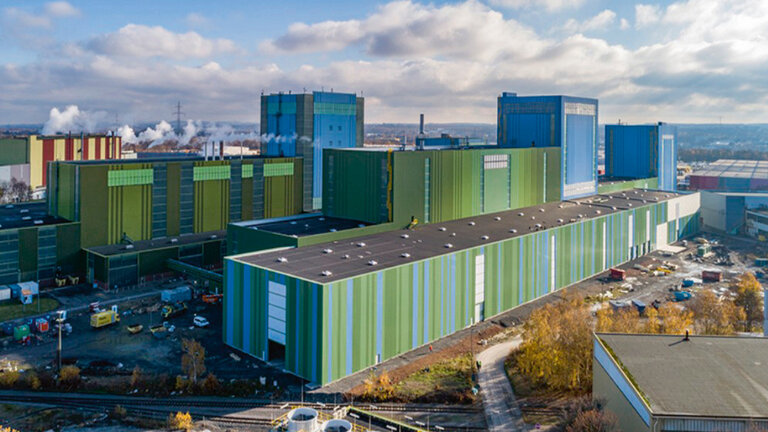Dortmund, Germany, November 28, 2022. It weighs in at 8,000 tons, with its steel structure rising to a height of more than 70 meters: thyssenkrupp Steel Europe AG in Dortmund is setting new standards with its innovative hot-dip galvanizing line.Together with the existing line at the Westfalenhütte, one million tons of steel strip per year will be hot-dip galvanized at the site. The easy-to-process and durable sheets are in demand mainly from car manufacturers and the home appliance industry. The new line was opened in October in the presence of Minister President Hendrik Wüst. Drees and Sommer’s experts for large-scale projects in industrial and plant engineering supported the construction project. Drees & Sommer SE is a real estate and building consultancy.
For Dr. Heike Denecke-Arnold, Chief Operating Officer of thyssenkrupp Steel, the new line is an investment with future potential for the site and sends an important signal to the workforce: ‘With the new hot-dip galvanizing line, our Dortmund site is developing into Europe's biggest competence center for hot-dip galvanized steel strip. This enables us to meet the requirements of our customers in the automotive and domestic appliance industries. Through this investment, we are not only securing the existing 1,300 jobs at the site, but also creating around 100 new jobs for highly qualified employees.‘ Hot-dip galvanized steel provides vehicles with long-lasting protection against corrosion. This makes the steel particularly sustainable, as it can be 100 percent recycled without loss of quality.
Multitasking-Based Construction Processes
The planning and construction of the ambitious steel structure, which is up to 75 meters high, faced special challenges right from the beginning. Several World War II bombs were found during site development and the civil engineering work. As they had to be made safe, construction was at risk of facing a very long delay. Klaus Martin, Drees & Sommer’s project team head responsible for site assembly, therefore relied on lean construction management to identify conflicts between individual trades and minimize time delays. ‘Unlike traditional construction management, in which a planner does not bring together the individual trades planned by various project participants until the end of the process, lean construction management focuses on collaboration from the very beginning. A lot of construction and assembly work, from the foundations to the steel structure hall through the line itself, had to be done in parallel and coordinated accordingly,‘ explained Klaus Martin.
The classic construction trades and plant engineering traditionally operate in separate teams. Drees & Sommer's integrated project management approach and the use of Drees & Sommer experts in both construction and assembly management enabled the representatives of the individual trades to merge into an integrated team, resulting in optimum processes and a smooth sequence of construction and assembly work. ‘We had a detailed workflow that was coordinated between the assembly and construction management teams, and scheduled exactly to the week. This meant that we knew at all times how many employees were on the construction site, and which materials and machines were needed at what time,‘ said Drees & Sommer’s expert. Using this method, construction specialists can accelerate progress in the construction phase compared to the conventional approach.
Large-Scale Site Logistics
For delivery and goods logistics alone, several hundred supplier firms had to be organized. The individual components for the hot-dip galvanizing line were manufactured in different countries, resulting in complex delivery logistics. In addition to the challenge of establishing a global supply chain for delivery in the right sequence to the Dortmund site, the restrictions resulting from pandemic-related measures worldwide made it difficult to ensure on-time delivery. Because much of the plant was delivered long before it was assembled in order to meet deadlines, a huge storage area along with warehouse management was also required. This was set up and kept available on a neighboring site. Deliveries had to be scheduled to prevent waiting times, and a road infrastructure with special access points had to be built that could also be used by heavy trucks. Last but not least, the appropriate staff had to be provided and organized. On some days, up to 20 trucks delivered goods, which had to be sorted, stored and labeled to ensure that assembly went smoothly at a later stage. At times, 15 to 20 employees worked two shifts just to receive and store goods. ‘We managed all of this by actively planning the construction and assembly process within the project. This also enabled us to compensate for delays in the downstream progress of construction and assembly,‘ sums up Klaus Martin.
